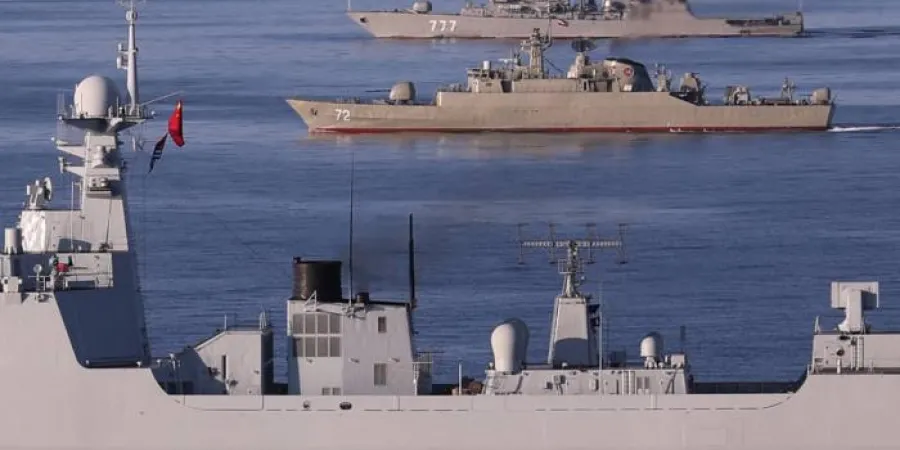The Naval Exercise in the Gulf: a Warning Sign for the USA
The naval maneuver in which naval forces from Iran, Russia and China participated practiced a naval warfare doctrine that includes two defensive loops against the USA. The exercise sends a significant message in the direction of the USA. Commentary
Cmdr. (res.) Eyal Pinko
| 07/01/2020
Over the last week of December 2019, a strategic multinational naval exercise was conducted by naval forces from Iran, China and Russia. The exercise took place in the sea area between the Straits of Hormuz and the Persian Gulf, all the way to the Indian Ocean.
Exercise participants included three destroyers of the regular Iranian navy, a Russian destroyer, a Chinese destroyer, and several vessels of the Iranian Islamic Revolutionary Guard Corps (IRGC), along with numerous aircraft and helicopters of both Iranian naval forces.
The exercise, conducted over the course of four days, included joint drills practicing the assembly of a maritime status picture, combat drills simulating attacks against US naval vessels, joint protection of naval vessels against US air strikes and missile attacks, protection of the maritime routes leading into and out of the Straits of Hormuz, and search and rescue drills. Some of the best naval vessels of the participating countries took part in the exercise, which included drills of launching state-of-the-art missiles and deploying torpedoes and naval mines.
A Multinational Naval Message to the USA
The exercise presents a strategic naval warfare doctrine that includes combat operations at long distances from the shore, with the intention of establishing two defensive loops against US forces. The first loop consists of fighting at very long ranges, intended to deny access toward the Persian Gulf and the Straits of Hormuz to US naval vessels. The actual fighting at these extreme ranges is to be performed by large surface vessels, submarines and aircraft operated by the Iranian regular navy, in cooperation with the warships of China and Russia.
The second defensive loop, implemented by the naval force of the IRGC, is deployed relatively close to the Iranian shore and Straits of Hormuz (within a range of up to 100 nautical miles). It is intended to prevent the US adversary from operating effectively, and from attacking targets (including high-value targets) deep inside Iranian territory, and even to deny the forces of the US Navy and US Marine Corps the ability to invade the Iranian shore, in the event that these forces had managed to break through the first defensive loop established by the Iranian regular navy.
The naval maneuver in which naval forces from Iran, Russia and China participated practiced a naval warfare doctrine that includes two defensive loops against the USA. The exercise sends a significant message in the direction of the USA. Commentary
Over the last week of December 2019, a strategic multinational naval exercise was conducted by naval forces from Iran, China and Russia. The exercise took place in the sea area between the Straits of Hormuz and the Persian Gulf, all the way to the Indian Ocean.
Exercise participants included three destroyers of the regular Iranian navy, a Russian destroyer, a Chinese destroyer, and several vessels of the Iranian Islamic Revolutionary Guard Corps (IRGC), along with numerous aircraft and helicopters of both Iranian naval forces.
The exercise, conducted over the course of four days, included joint drills practicing the assembly of a maritime status picture, combat drills simulating attacks against US naval vessels, joint protection of naval vessels against US air strikes and missile attacks, protection of the maritime routes leading into and out of the Straits of Hormuz, and search and rescue drills. Some of the best naval vessels of the participating countries took part in the exercise, which included drills of launching state-of-the-art missiles and deploying torpedoes and naval mines.
A Multinational Naval Message to the USA
The exercise presents a strategic naval warfare doctrine that includes combat operations at long distances from the shore, with the intention of establishing two defensive loops against US forces. The first loop consists of fighting at very long ranges, intended to deny access toward the Persian Gulf and the Straits of Hormuz to US naval vessels. The actual fighting at these extreme ranges is to be performed by large surface vessels, submarines and aircraft operated by the Iranian regular navy, in cooperation with the warships of China and Russia.
The second defensive loop, implemented by the naval force of the IRGC, is deployed relatively close to the Iranian shore and Straits of Hormuz (within a range of up to 100 nautical miles). It is intended to prevent the US adversary from operating effectively, and from attacking targets (including high-value targets) deep inside Iranian territory, and even to deny the forces of the US Navy and US Marine Corps the ability to invade the Iranian shore, in the event that these forces had managed to break through the first defensive loop established by the Iranian regular navy.



